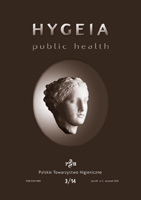Home page |
Editorial Board |
Editor |
Subscription |
Infomation for authors |
Conferences |
Partners

|
|
|
ISSN 1509-1945
 
 
  search by |
Hygeia Public Health 2018, 53(1): 96-99pl
 Fatty acids and lipids profile among hypertensive people using optimal dietIzabela Bolesławska 1/, Grzegorz Kosewski 1/, Paweł Jagielski 2/, Jaśmina Żwirska 2/, Hanna Płuszka 1/, Juliusz Przysławski 1/ 1/ Katedra i Zakład Bromatologii, Uniwersytet Medyczny im. Karola Marcinkowskiego w Poznaniu 2/ Zakład Żywienia Człowieka, Uniwersytet Jagielloński Collegium Medicum w Krakowie Summary Introduction. Hypertension is one of the main risk factors for advancement of cardiovascular diseases, for instance coronary artery disease, stroke, heart failure, and peripheral atherosclerosis. Aim. The determination of lipid profile and fatty acids in people diagnosed with hypertension, using the optimal diet. Material and method. The research was conducted in 2016 in a group of 25 people (15 males, 10 females), aged 26-61 years, diagnosed with hypertension, using the optimal diet. The concentration of total cholesterol, HDL, and triglycerides in blood serum were marked by the enzymatic-colometric method. The LDL concentration was calculated by the Friedewald equation. Fatty acids were determined by the gas chronomatography method (GC) using the Hewlett-Packard equipment number 6890. Results. In the people with hypertension, using the optimal diet, total cholesterol and LDL levels were above the recommended values. The HDL levels were compatible with the desired values or higher, moreover the triglyceride levels among the females were comparable with the mean recommended norms, yet among the males they were too high. The marked percentage contribution of fatty acids was higher than the reference value in both researched groups; on the other hand in case of monounsaturated fatty acids, n-6 acids and P/S it was below the recommended values. In female blood serum, the percentage of monounsaturated fatty acids was higher, among the males it was close to the reference values. A high percentage value of n-3 fatty acids and low of acids with Hylip properties were observed, which may act protectively in case of hypertension. Conclusion. Many anomalies were observed pertaining fatty acids and the lipid profile. Interesting may seem the fact of high percentage contribution of n-3 fatty acids and low Hylip properties. Key words: serum lipid profile, serum fatty acids, optimal diet |


